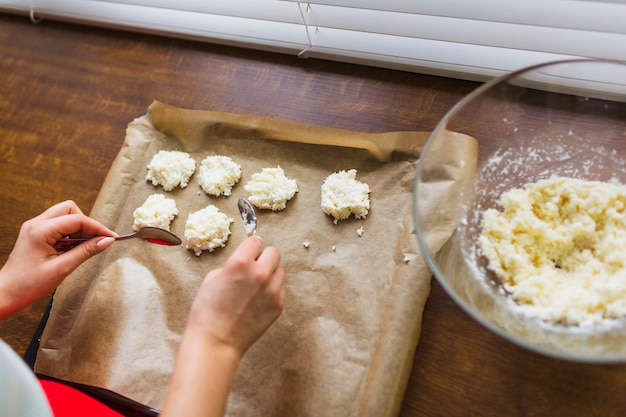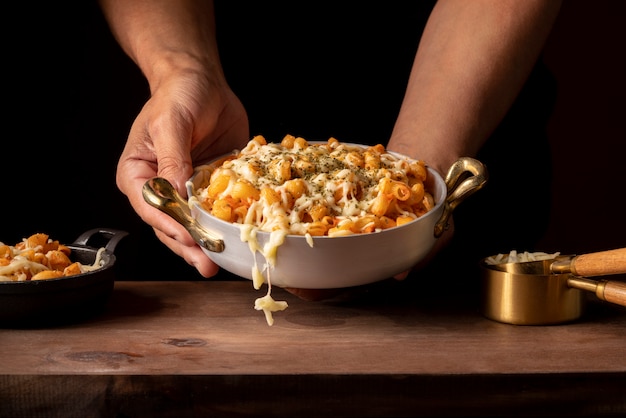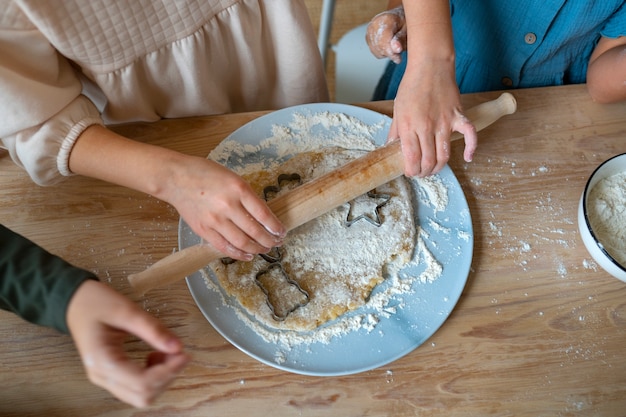There's a certain magic in the aroma of lasagna baking in the oven. That comforting blend of tomato, herbs, and melted cheese, all simmering and bubbling, is enough to make anyone's heart sing. But crafting the perfect lasagna isn't just about throwing ingredients together. It requires a touch of finesse, a sprinkle of patience, and a keen understanding of how temperature and time intertwine to create culinary magic. Today, I'm going to take you on a journey through my own lasagna-making experiences, sharing tips and tricks I've learned along the way. We'll delve into the importance of 375 degrees Fahrenheit, explore the secrets of different lasagna variations, and ultimately, guide you towards creating a masterpiece that'll have everyone clamoring for seconds.
(Part 1) The Importance of Patience: Why 375 Degrees is Your Friend

Now, you might be thinking, "Isn't 375 degrees just the standard oven temperature for everything?" And you'd be right, but for lasagna, it's more than just a routine setting. It's the golden key to unlocking a symphony of flavors and textures. You see, lasagna is a layered dish – pasta, sauce, cheese – each with its own cooking needs. And that's where patience comes into play. Cooking at a lower temperature ensures that all the layers cook thoroughly and meld together beautifully, creating a harmonious blend that's simply divine.
The Science Behind 375 Degrees
Let's get a little technical for a moment. The ideal internal temperature for lasagna is around 165 degrees Fahrenheit. 375 degrees allows for even heat distribution, reaching that perfect temperature without scorching the top layer of cheese before the pasta and sauce are fully cooked. Picture this: you're trying to bake a cake at the highest setting – disaster! The outside would be burnt to a crisp, while the inside would remain raw. 375 degrees, on the other hand, is like a slow, gentle embrace, allowing the heat to penetrate the lasagna without any rushed or uneven cooking.
My Personal Experience: The Time I Burned the Cheese
Speaking of disaster, I'll never forget the time I tried to speed up the process by cranking the oven up to 400 degrees. Let's just say the cheese was a crispy, burnt mess before the pasta even softened. Lesson learned: patience is key! It's like watching a good film – you savour every moment, every detail. Rushing the process is like skipping to the end; you miss out on the nuanced enjoyment.
(Part 2) Building the Perfect Foundation: The lasagna layers

Now, let's talk about the building blocks of your lasagna masterpiece. The layers are what define its character and create that satisfying combination of textures. It's a bit like building a house – each layer plays a crucial role in the overall structure and appeal.
The Base: The Pasta Sheets
These are your foundation, the canvas on which you paint your culinary masterpiece. I prefer using fresh pasta sheets – they have a slightly more delicate texture and absorb the sauce beautifully. But if you're going for a classic feel, dried pasta sheets work just fine. Remember, the pasta needs to be cooked al dente – that slight firmness ensures it doesn't turn into mush when baked. It's the perfect balance – a subtle resistance that melts in your mouth with each bite.
The Filling: The Sauce
This is where you let your creativity shine! You can go with a traditional meat-based sauce or explore vegetarian options, using vegetables like mushrooms, eggplant, or spinach. For a truly authentic Italian experience, try using a slow-cooked meat sauce, letting the flavors develop over time. A flavorful sauce acts as the glue that binds all the layers together, creating a rich and satisfying tapestry of tastes.
The Finishing Touch: The Cheese
This is where the magic truly happens! I'm a big fan of a combination of ricotta cheese, mozzarella, and Parmesan. The ricotta adds creaminess, the mozzarella melts beautifully, creating that gooey, stringy goodness, and the Parmesan adds that salty, nutty depth of flavor. But feel free to experiment! Try adding a sprinkle of provolone for a sharper taste, or even some goat cheese for a tangy twist. The key is to find a cheese combination that speaks to your palate and complements the other flavors in your lasagna.
(Part 3) The Lasagna Assembly: A Step-by-Step Guide

You've got all your ingredients ready, now it's time to assemble your masterpiece! It's like putting together a jigsaw puzzle, each piece playing a crucial role in creating the final picture. Here's a step-by-step guide to help you along the way:
Step 1: The Bottom Layer
Start by spreading a thin layer of sauce in your baking dish. This will help prevent the pasta from sticking and create a delicious base for your lasagna. Imagine it as the first brushstroke on a blank canvas, setting the stage for the layers to come.
Step 2: Layer by Layer
Next, start layering your pasta sheets, sauce, and cheese. I usually place two pasta sheets at the bottom, followed by a generous layer of sauce and cheese. Repeat this process until your baking dish is filled. Think of it as building a tower, each layer adding to the height and complexity of your culinary creation.
Step 3: The Top Layer
Finish with a final layer of pasta, sauce, and cheese, ensuring that the top layer is generously covered in cheese. This will create a beautiful golden-brown crust as your lasagna bakes, adding a touch of visual appeal to your culinary masterpiece.
Step 4: The Baking Process
Cover your lasagna with foil and bake for 30 minutes at 375 degrees Fahrenheit. This will allow the pasta to cook through and the flavors to meld together. After 30 minutes, remove the foil and bake for an additional 15 minutes, or until the cheese is melted and bubbly. This final stage is like letting the painting dry, allowing the colors to set and the flavors to deepen.
(Part 4) Variations on a Theme: Exploring Different lasagna recipes
Lasagna is a wonderfully versatile dish that can be adapted to suit all tastes and preferences. It's like a blank canvas that you can personalize with your own unique touch. Here are a few variations you can explore:
1. vegetarian lasagna
If you're looking for a meat-free option, you can easily swap out the traditional meat sauce for a delicious vegetable-based sauce. I love using mushrooms, eggplant, and spinach, but you can use any vegetables you like. Think of it as a garden in your dish – a vibrant array of textures and flavors that will tantalize your taste buds.
2. White Lasagna
This variation ditches the red sauce for a creamy white sauce, usually made with ricotta cheese, parmesan cheese, and a touch of milk or cream. It's a lighter, more delicate option, like a whisper of flavors against your palate.
3. Spinach and Ricotta Lasagna
This is a classic Italian favorite. It features layers of fresh spinach, ricotta cheese, and mozzarella cheese. It's a simple but delicious option, like a classic song – familiar, comforting, and always satisfying.
(Part 5) The Importance of Timing: Understanding Cooking Time
Now, let's talk about the heart of this article: the cooking time. 375 degrees Fahrenheit is your magic number, but how long should you bake your lasagna? The answer is: it depends!
Factors Affecting Cooking Time
Here are a few factors that influence the cooking time:
- Lasagna Size: A larger lasagna will obviously take longer to cook than a smaller one. Imagine baking a small loaf of bread versus a large one – the smaller one will be done much faster.
- Type of Pasta: Fresh pasta cooks faster than dried pasta. Fresh pasta is like a sponge, soaking up the flavors and moisture quickly, while dried pasta needs a little more time to soften and absorb the sauce.
- Oven Variations: Every oven is different. Some ovens run hotter or cooler than others. Just like people, ovens have their own unique personalities. It's important to learn your oven's quirks and adjust cooking times accordingly.
How to Tell If Your Lasagna is Done
The best way to know if your lasagna is cooked through is to insert a thermometer into the center. It should register at least 165 degrees Fahrenheit. If you don't have a thermometer, you can use the following signs:
- The cheese should be melted and bubbly, like a molten river of cheesy goodness.
- The pasta should be tender and cooked through, offering a soft and yielding bite.
- The sauce should be bubbling and thickened, a symphony of flavors that dance on your tongue.
(Part 6) Troubleshooting: Common Lasagna Mishaps
Even experienced cooks can run into a few hiccups in the kitchen. It's like life – unexpected challenges can arise, but with a little knowledge and a positive attitude, you can overcome them. Here are some common lasagna problems and how to fix them:
1. Dry Lasagna
If your lasagna is dry, it could be due to insufficient sauce or a long cooking time. Think of it like a dessert – a little moisture goes a long way. Add more sauce before baking or shorten the cooking time.
2. Soggy Lasagna
If your lasagna is soggy, it could be because the pasta sheets weren't cooked al dente or there was too much sauce. Remember, the pasta should be firm enough to hold its own, not turn into mush. Next time, make sure to cook the pasta al dente and use less sauce.
3. Burnt Cheese
This is a common problem that can be avoided by covering your lasagna with foil for the first 30 minutes of baking. It's like a protective shield, preventing the cheese from browning too quickly before the pasta and sauce have a chance to cook through.
(Part 7) Finishing Touches: The Art of Presentation
You've gone through all the effort of creating a delicious lasagna, now it's time to present it with flair. It's like putting the finishing touches on a painting – a little bit of presentation goes a long way.
1. Garnish
Sprinkle some fresh parsley, basil, or oregano on top of your lasagna for a touch of color and freshness. Think of it as a sprinkle of confetti, adding a touch of joy and vibrancy to your dish.
2. Serve with a Salad
A simple side salad with a light vinaigrette balances out the richness of the lasagna. It's like a palate cleanser, refreshing your senses and preparing you for the next bite.
3. The Presentation Plate
Serve your lasagna on a beautiful serving dish or platter, and don't forget the napkins! Think of it as setting the stage for a delicious performance – a beautiful backdrop for your culinary masterpiece.
(Part 8) Beyond the Dish: The Importance of Sharing
Finally, lasagna isn't just about the food; it's about the people you share it with. It's a dish that brings people together, fosters conversation, and creates lasting memories. Think of it as a warm hug, enveloping you in its comforting embrace. So, the next time you're feeling a bit overwhelmed or just want to spread some love, make a lasagna. It's a surefire way to make everyone's day brighter.
FAQs
Here are some frequently asked questions about lasagna:
1. Can I make lasagna ahead of time?
Yes, you can definitely make lasagna ahead of time. In fact, it's often recommended! Make the lasagna as usual, but then cover it tightly with plastic wrap and refrigerate for up to 24 hours. When ready to bake, remove the lasagna from the fridge and let it come to room temperature for 30 minutes before baking. This will ensure that the lasagna cooks evenly and doesn't get soggy. It's like giving the lasagna a chance to relax and settle before its grand entrance into the oven.
2. Can I freeze lasagna?
You can freeze lasagna, but it's best to freeze it unbaked. Assemble the lasagna as usual, but don't bake it. Cover the baking dish tightly with plastic wrap and then foil, and freeze for up to 3 months. When ready to bake, thaw the lasagna in the refrigerator overnight. Remove the plastic wrap and foil, and bake according to the recipe instructions. It's like putting your lasagna on hold, preserving its flavor and texture for a later date.
3. How do I reheat lasagna?
To reheat lasagna, preheat your oven to 350 degrees fahrenheit. Cover the lasagna with foil and bake for 20-30 minutes, or until heated through. You can also reheat lasagna in the microwave, but be careful, as it can get very hot! It's like bringing back to life a culinary memory, warming it up and making it ready to enjoy once more.
4. What is the best way to store leftover lasagna?
Store leftover lasagna in an airtight container in the refrigerator for up to 3 days. You can also freeze leftover lasagna for up to 3 months. It's like a little treasure you can keep for later, a delicious reminder of a culinary adventure.
5. What are some other things I can make with lasagna leftovers?
Lasagna leftovers are great for making lasagna fritters, lasagna soup, or a delicious lasagna salad. You can get creative and use them in any dish where you'd use pasta, meat sauce, and cheese. It's like giving your culinary masterpiece a second act, transforming it into new and exciting dishes.
Everyone is watching

How to Cook Frozen Lobster Tails Perfectly: A Step-by-Step Guide
RecipesLobster. Just the word conjures up images of lavish meals, special occasions, and a taste of luxury. But let's...

Pork Fillet Cooking Time: How Long to Cook It Perfectly
RecipesPork fillet, or tenderloin as it's sometimes called, is a real favourite in our house. It's so versatile, and...

Pigs in a Blanket Cooking Time: How Long to Bake for Perfect Results
RecipesAh, pigs in a blanket. Just the name conjures up images of those delightful little parcels of crispy pastry en...

The Ultimate Guide to Cooking Delicious Frankfurters
RecipesLet's face it, we all love a good frankfurter. It's a classic, simple, and always satisfying. But let's be rea...

Wolf Meat Recipes: A Guide to Cooking Wild Game
RecipesLet's be honest, you don't see wolf meat at your local butcher shop every day. It's a bit of a wild card, but ...
